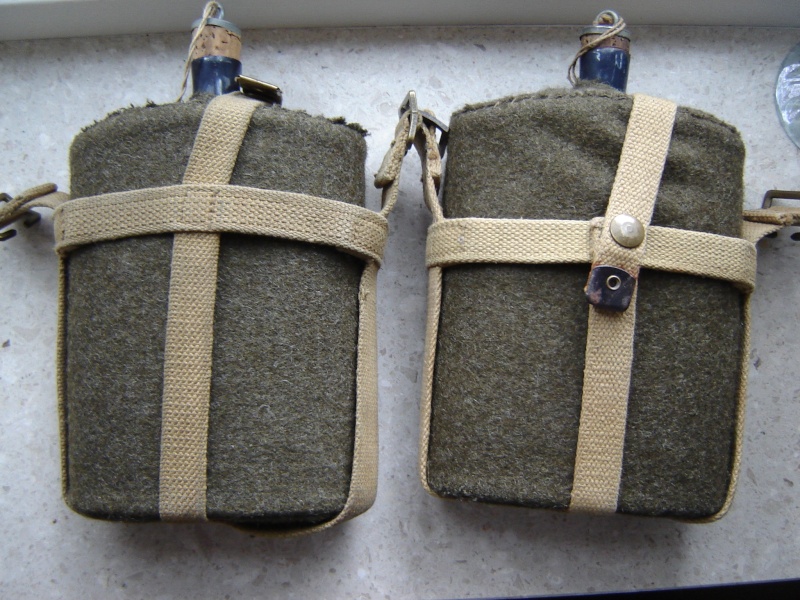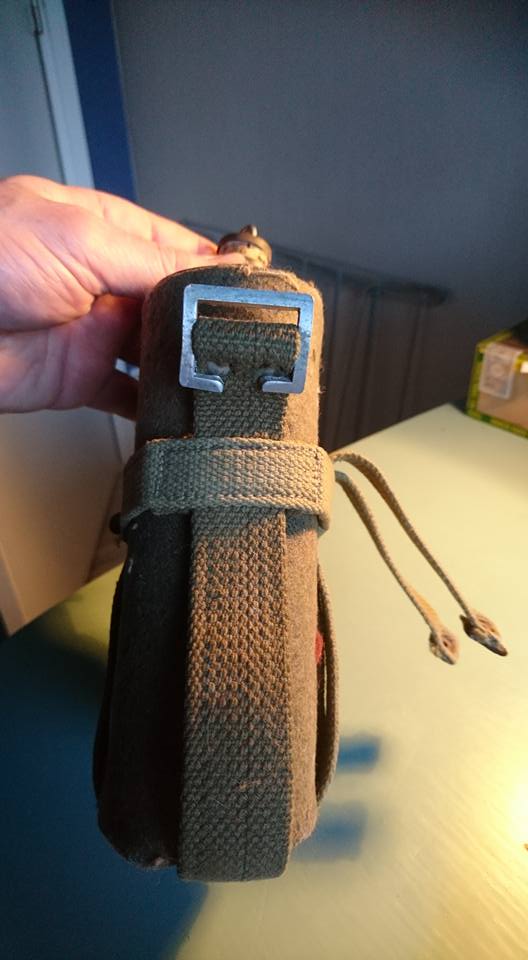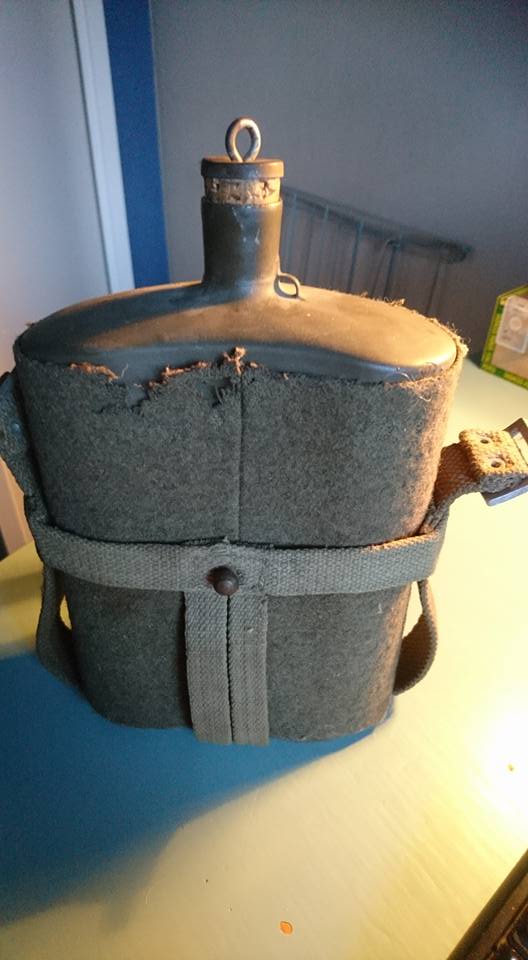WATER BOTTLES OF THE BRITISH EMPIRE
The enamel water bottle used by British Empire Forces at the start of the Second World War dates back to 1903, when the ‘bottle, water, enamelled (Mark VI)’ was approved. With a kidney shape similar to a flask the Mark VI, and later Mark VII, consisted of an enameled iron bottle covered with wool and closed with a cork stopper on a string. During its service life, a number of variants were manufactured in different parts of the empire and an assortment of webbing and leather harnesses were developed for use with this style of water bottle.
BRITAIN – Mark VI in a Pattern 1908 Carrier
The Mark VI was the standard issue water bottle for British forces during the Great War and by 1939 they were still in fairly common use. The Mark VI is recognizable by its cobalt blue enamel and thick khaki felt cover with the long 18 inch stopper cork cord being stitched directly to the cover. This particular Mk VI has a flat top attached to the body with a ‘tin can’ type seam.
The webbing is the third issue of the Pattern 1908 carrier, with a long front closure strap. After 1921, 1908 carriers converted to a top closure stud with two short straps. This carrier was made by Mills Equipment Company (M.E.CO.) in 1918.

BRITAIN – Mark VI in a Pattern 1919 Carrier
The Mark VI water bottle shown here has a pressed top with curved shoulders and a rounded spout.
The webbing carrier shown is from the 1919 pattern naval set and has a front closure just like the 1908 pattern. This carrier was made by Mills Equipment Company (M.E.Co.) in 1926.

BRITAIN – Mark VI in a Pattern 1919 Carrier
Close up of the rounded edge on the spout of the previous Mark VI.

BRITAIN – Mark VI in a Water Bottle Carrier, Mark II
In 1933, new covers were approved for the Mark VI water bottle consisting of drab cloth that was much thinner and greener than the old khaki felt pattern (from that point designated as the ‘old pattern’).
The ‘Water Bottle Carrier, Mark II’ shown here was introduced in 1905 for personnel not issued with 1908 pattern webbing. Although commonly associated with the 1903 pattern bandolier equipment, it was not officially listed under that pattern. This carrier was made by ‘A.Wood – Walsall’ in 1917.

BRITAIN – Mark VI in a Water Bottle Carrier, Mark II
Close up of the long 18 inch stopper cord stitched directly to the new ‘cover, water-bottle, cloth, drab mixture’.

BRITAIN – Mark VII in a Webbing ‘Other Services’ Water Bottle Carrier
The Mark VII water bottle was introduced in 1939 and featured green enameling and a small wire eye for the stopper cord on the left side of the spout. The stopper cord itself was shortened from 18 to 9 inches as well. Although this particular example has cobalt blue enamel, a flat top with ‘tin can’ seam & a thick grey felt cover, its wire loop (located behind the spout) and 9 inch stopper cord make it a Mark VII.
The carrier is the webbing version for ‘other services’ not issued with 1937 pattern, which replaced the leather carrier in 1943. This carrier was made by Martin Wright & Sons Limited (M.W. &S. Ltd.) in 1944.

BRITAIN – Mark VII in a Pattern 1937 Short Bucket-Type Carrier
Standard Mark VII water bottle with green enamel and wire loop on the left side of the spout for the 9 inch stopper cord.
The carrier is the 1937 pattern bucket-type that the British Army adopted in 1940 over the webbing framework type. This is an early example made with narrow webbing, which leaves the top of the water bottle exposed. These short carriers were made by firms other than M.E.Co. & M.W. & S. Ltd., which did not have the appropriate webbing stocks to produce the full length version. This carrier was made by Thos. Sampson (Oldham) Limited (T.S. (O) Ltd.) in 1941.

BRITAIN – Mark VII in a Pattern 1937 Bucket-Type Carrier
Another standard Mk VII water bottle; here completely obscured by the webbing carrier.
The carrier is the 1937 pattern bucket-type in its true form, a direct copy of the 1925 pattern carrier in khaki. This carrier was made by Frenchs Limited (F. Ltd.) in 1943.

CANADA – Mark VI in a Canadian-Made Pattern 1937 Carrier
Canadian-made water bottles were nearly exact copies of the British Mark VI and featured cobalt blue enamel, thick khaki felt covers and 18 inch stopper cords. Unlike the British Mark VI, the Canadian version had a metal staple for the stopper cord located on the shoulder of the bottle.
The carrier is the Canadian variant of the 1937 pattern that appeared in 1942, which reverted to the front closure stud of the 1908 & 1919 patterns. This carrier was made by Zephyr Loom and Textiles Limited (Z.L. &T. Ltd.) in 1942.

AUSTRALIA – Mark VI in an Australian-Made Water Bottle Carrier, Mark II
Australia’s water bottles followed the Mark VI specifications with cobalt blue enamel and 18 inch stopper cords that were stitched directly to the cover. Covers were made of a thin drab cloth in a green shade of khaki.
The carrier is an Australian leather Mark II with little to distinguish it from a British-made example. This carrier was made by ‘W.H. Hunter & Company – Saddlers – Melbourne’ in 1910.

AUSTRALIA – Mark VI in an Australian-Made Pattern 1937/1943 Carrier
This Australian Mark VI has an Australian Government ownership mark (a broad arrow in the middle of two letter ‘D’s) stamped into the metal top of the cork stopper.
The webbing carrier shown is an Australian variant that appeared in 1943 for Jungle use. It features brass belt hooks on the back for mounting the water bottle above the waist. This carrier was made by C&H in 1945.

AUSTRALIA – Mark VI in an Australian-Made Pattern 1937/1943 Carrier
Back of the Australian 1943 pattern carrier, showing the distinctive belt hooks.

AUSTRALIA – Mark VI in an Australian-Made Pattern 1937/1943 Carrier
Close up of the Australian Government ownership mark on the water bottle stopper.

NEW ZEALAND – Mark VII in British-Made Pattern 1937 Carrier
Although New Zealand-made water bottles feature cobalt blue enamel and a flat top with a ‘tin can’ seam, their wire loop (behind the spout) and 9 inch stopper cord make them a Mark VII. New Zealand water bottles are readily identified by their removable brown covers and wooden or rubber stoppers. This particular water bottle features a wood stopper and was made by National Electrical and Engineering Company Limited (NEECO) of Wellington, New Zealand.
The carrier is the framework-type that was included in the original 1937 pattern webbing set. New Zealand did not produce their own webbing during the Second World War and relied heavily on British-made stocks. This carrier was made by Hampton & Sons Limited (H&S Ltd.) in 1940.

NEW ZEALAND – Mark VII in British-Made Pattern 1937 Carrier
Close up of the wooden stopper and wire loop located on the back of the spout.

NEW ZEALAND – Mark VII in British-Made Pattern 1937 Carrier
Close up of the bottom of the New Zealand-made water bottle showing the drawstring that allows the cover to be removable as well as maker information.

INDIA – Mark VII in an Indian-Made Pattern 1937 Carrier
India, like most of the Empire, produced their own Mark VII water bottle during the war. However, Indian water bottles are nearly indistinguishable from other Empire-made Mark VII’s. The water bottle shown here is a classic Mark VII that came with an Indian-made 1937 pattern carrier. It features a loop made from a thin strip of metal, rather than wire, as well as a rubber stopper with the letters “B.R.W.”. Indian origin is not certain, but very possible.
The Indian-made 1937 carrier is readily identified by the use of a buckle closure, rather than a snap. This carrier was made by the Indian firm ‘Ca’ in 1943.

INDIA – Mark VII in an Indian-Made Pattern 1937 Carrier
Close up showing the rubber stopper and buckle closure.

SOUTH AFRICA – Mark VI in a South African-Made Pattern 1937 Carrier
It is unclear whether South Africa produced water bottles during the Second World War, but British-made Mark VI & VII’s would certainly have been used. The bottle shown here is a British-made Mark VI with cobalt blue enamel and a thick khaki felt cover.
The South African-made 1937 pattern carrier could be very distinctive depending on its manufacturer. The South African firm SAPAW Limited made carriers very similar to the British pattern (with alloy fittings in place of brass), while D.I. Fram & Company Limited made carriers out of multiple layers of thin webbing with lines of stitching for support. Both companies relied on Canadian-made snaps. This carrier was made by D.I. Fram & Company Limited (D.I.F. & Co. Ltd.) and is undated.





 " />
" /> " />
" />

